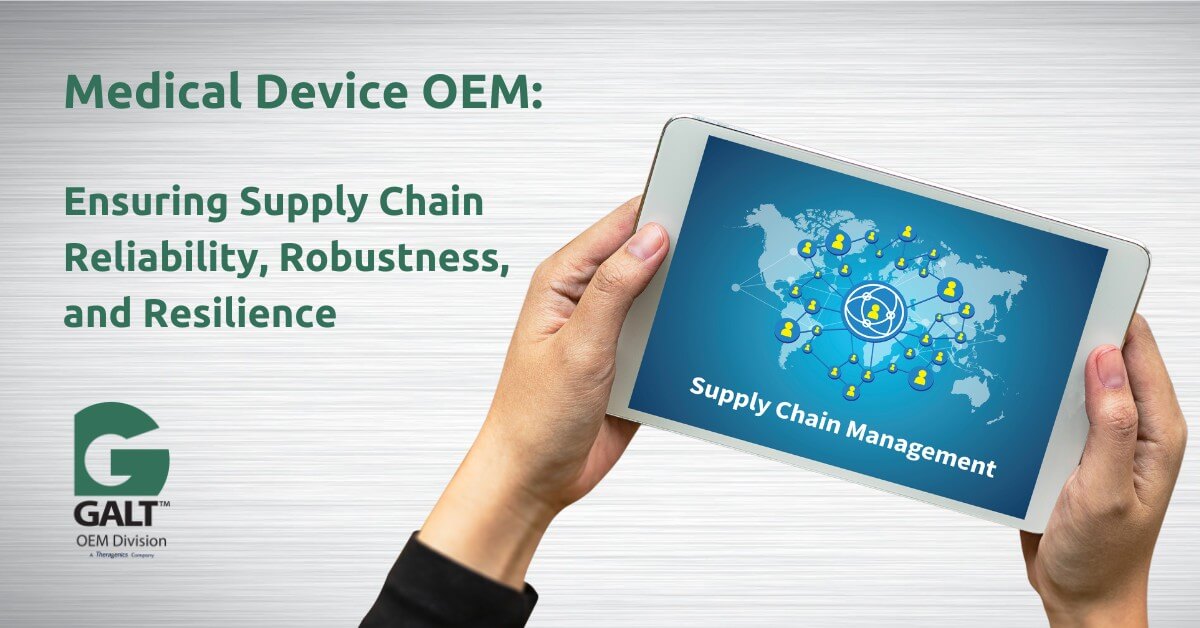Ensuring Supply Chain Reliability and Robustness as a Medical Device OEM

As a medical device OEM, the quality, reliability, robustness, and resilience of your supply chain are crucial to the success of your business. As a result, optimizing your supply chain should be a high-priority and ongoing process.
This includes overcoming the challenges of ensuring the reliability and robustness of your supply chain. We’ll look at those challenges and the steps you can take to overcome them in this blog.
The Importance of a Robust and Reliable Supply Chain
We have already highlighted the importance of your supply chain to the success of your business. This can be broken into several key areas where your supply chain plays an essential and indispensable role:
- Ensuring patient safety through the production of high-quality, defect-free products.
- Preventing product recalls that have an immediate cost as well as ongoing financial and reputational impacts.
- Maintaining compliance, including in the current market where regulations continuously evolve.
- Preventing disruptions in patient care when products are delayed or unavailable, potentially forcing your customers to find an alternative product.
- Protecting commercial contracts and agreements by ensuring you can meet order quantities and deadlines.
- Protecting your market reputation, especially as a partner in the supply chains of your customers.
- Maintaining production, assembly, and logistics process efficiency in your operations.
Supply chain reliability also allows your resources (which can be limited) to focus on tasks that are value-adding to your business. This is because those resources can spend less time on supply chain management when you have confidence in your supply chain’s resilience, reliability, and robustness.
The Challenges of Supply Chain Management for Medical Device OEMs
Supply chain management and ensuring your supply chain is reliable and robust involves making decisions that benefit your business, i.e., purchasing the best components, the most cost-effective solution, etc.
Supply chain optimization is also about risk management and mitigation. We will explore the main risks and challenges in the next section of this blog. They include:
- Component and part availability and lead times
- Scalability
- The reliability of your supplier’s supply chain
- Responding to changing market conditions
- Regulatory compliance
- Supply chain visibility
- Cost management and value for money
Component and Part Availability and Lead Times
The most straightforward supply chain disruption situation is where a product or component is not available when you need it. A related challenge is when your supply chain partner has long lead times for orders (or lead times that are longer than normal).
Scalability
You need to work with supply chain partners who have the capability and, crucially, the capacity to meet the changing needs of your business as you scale. Supply chain risks significantly increase if your partners are running at capacity simply to meet your existing requirements.
The Reliability of Your Supplier’s Supply Chain
The robustness of your supplier’s supply chain is also an important consideration as there is a domino effect at play, i.e., if your supplier’s supplier fails to meet their obligations, what impact will that have on the availability of the parts and components that you need?
Responding to Changing Market Conditions
The last number of years have put a spotlight on the importance of resilience and the ability to respond to changing market conditions, from financial shocks to the economy to geopolitical upheaval to pandemics and other substantial unforeseen events.
Regulatory Compliance
Maintaining regulatory compliance is an ongoing challenge that requires constant emphasis and focus.
Supply Chain Visibility
If a problem in your supply chain is already well-established before you become aware of it, it is likely too late to implement a 100 percent effective solution. You need visibility across your entire supply chain to ensure you are as agile as possible and can react early and decisively.
Cost Management and Value for Money
Managing costs is an important part of supply chain management and optimization, but there should also be a focus on value for money. Are you spending as little as you can get away with or are you getting true value for money – these are not the same thing. Striving for value for money is the best approach where you take into account factors such as available capacity, lead times, customisation options, and value-added services.
How to Ensure Your Supply Chain is Reliable and Robust
The starting point in ensuring your supply chain is reliable and robust is the selection of suppliers. The best approach is to choose suppliers that help you mitigate the risks and overcome the challenges highlighted in the previous section.
You then need to continuously build on the relationships you have with your supply chain partners with effective communication being a core component.
Continuous process optimisation and improvement are essential too. This includes:
- Forecasting and planning
- Inventory management
- Regulatory compliance
- Quality assurance
- Risk management
- Data-driven decision-making
How Galt Can Improve the Reliability and Robustness of Your Supply Chain
If you need access components for your medical device products, Galt can help improve your supply chain reliability and robustness. We have extensive manufacturing capabilities and facilities, our products can be supplied in a range of configurations (including customized and value-added configurations), and we have built-in capacity to scale the supply of components according to the needs of your business. Get in touch today to arrange a consultation with a member of our team.
.
.
